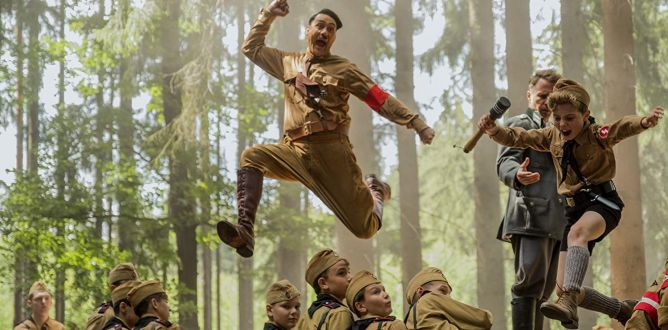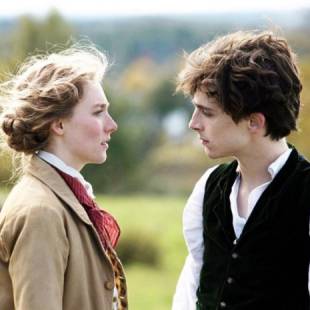Jojo Rabbit Parent Guide
This is a complex film, part drama, part dark comedy. When the balls all stay in the air, the satire is brilliant. But when the balls fall, it gets cringeworthy.
Parent Movie Review
It’s not unusual for a child to have an imaginary friend, but when that friend is Adolf Hitler, things are going to get weird very quickly.
Ten-year-old Jojo Betzler (Roman Griffin Davis) lives in the Third Reich and idolizes the Fuehrer to the point that Hitler (Taika Waititi) has taken up residence in his subconscious, to emerge as a friend, teacher, and guide. Determined to be the best Nazi ever, Jojo is all fired up about attending a Hitler Youth camp, until his inability to kill a rabbit gets him nicknamed “Rabbit”. Then his Hitler avatar encourages him to demonstrate his bravery and the resulting grenade mishap leaves Jojo scarred and limping.
Back at home with his brisk, playful mother (Scarlett Johansson), Jojo stumbles into a horrifying secret: his own parent is betraying the Fatherland by hiding a Jewish girl named Elsa (Thomasin McKenzie) in the walls of his deceased sister’s bedroom. Jojo now faces a terrible dilemma: if he turns Elsa in, his mother will be arrested, but if he keeps silent, he is complicit in her treachery.
Jojo Rabbit is a complex film: part drama, part dark comedy, it’s also an exploration of the lies we tell ourselves and the dangers of uncritically absorbing our cultural zeitgeist. That’s a lot of balls to keep in the air. When director Taika Waititi manages it, the movie delivers biting satire with precision. But when the balls start to fall, the movie can struggle with cringeworthy moments, Nazi jokes that don’t land, and a main character who, although vulnerable and sympathetic, can also be unlikable.
The biggest issue with this movie isn’t the violence (which is sanitized but still heartbreaking) or the profanity, it’s trying to build comedy around Nazis. It has been argued that mocking Nazis diminishes them but making jokes out of the Holocaust is a bridge too far. While I can appreciate that distinction intellectually, I can’t escape the visceral response in my gut when Hitler Youth throw books on a bonfire and discuss how to identify Jews (horns and a smell of brussels sprouts). I know that Waititi, who is himself Jewish, is pointing out the lunacy of anti-Semitism when Jojo creates a handmade book on how to identify Jews, which he fills with absurd racist tropes and disturbing line drawings.
This is a difficult film to recommend for a mass audience. Although the script is clever and the acting is excellent – Roman Griffin Davis is astoundingly talented for a child actor, Rebel Wilson and Sam Rockwell shine as Nazi youth leaders, and Thomasin McKenzie is heartbreakingly vulnerable as Elsa – this is a very, very dark film. Older teens and adults who enjoy satire, dark comedy, and long debates after a movie will probably enjoy Jojo Rabbit. But anyone looking for a popcorn flick with lots of laughs will want to hop on past this feature and find something a bit more cheerful.
Directed by Taika Waititi. Starring Roman Griffin Davis, Scarlett Johannson, and Taika Waititi. Running time: 108 minutes. Theatrical release November 1, 2019. Updated April 6, 2020Watch the trailer for Jojo Rabbit
Jojo Rabbit
Rating & Content Info
Why is Jojo Rabbit rated PG-13? Jojo Rabbit is rated PG-13 by the MPAA for mature thematic content, some disturbing images, violence, and language.
Violence: A man repeatedly shoots firearms over the heads of a group of children. Children are taught to use guns and throw grenades. Boys grapple in war games. A teacher draws a picture of a Jewish “demon”. A boy is ordered to kill a rabbit; when he refuses an older boy snaps its neck and throws it away. Youth throw books on a bonfire. A child gets pushed to the ground by older teens who threaten him. A character gets kicked and slapped. Corpses are seen hanging from nooses in the public square on two occasions. On the second occasion, a child recognizes his mother as one of the dead. A child falls down the stairs. A child makes violent drawings and racist drawings about Jews. A child screams during treatment for an injury. A wounded soldier with a bloodstained bandage on his head is seen. A battle takes place in the town: weapons fire, explosions take place, and people are shown being hit with bullets and blasted aside by explosives. Dead bodies are seen but with little blood. Children are drafted into the military at very early ages and given weapons. A distraught child stabs a young woman; the wound is shallow and she is not seriously injured. Hitler’s suicide is mentioned: his avatar is shown with a bullet wound in his head. A man spits at a child. A young woman slaps a boy.
Sexual Content: Girls are told their job is to become pregnant. A child talks about penises in a racist context. Hitler’s genitals are briefly mentioned. Frightened Germans discuss Russian soldiers raping women and having sex with dogs.
Profanity: There are approximately 15 profanities in the movie, including one sexual expletive, about a dozen moderate profanities (scatological and anatomical terms), and a handful of terms of deity. There are also numerous racist comments about Jews.
Alcohol / Drug Use: A mother frequently drinks wine out of the bottle. A youth leader carries a flask filled with alcohol which he drinks from regularly throughout the day. An imaginary character frequently offers cigarettes to a child. A soldier is briefly seen smoking a cigarette.
Page last updated April 6, 2020
Jojo Rabbit Parents' Guide
Setting a comedy in Nazi Germany stirred up a fair bit of controversy. Do you think director Taika Waititi managed to deliver his message without trivializing the horrors of the Third Reich? Do you think it’s possible to make a comedy set in a regime that is practicing genocide?
What message do you think Jojo Rabbit is trying to deliver to audiences? Do you think it’s effective? Do you agree with it?
Loved this movie? Try these books…
Jojo Rabbit is based on Christine Leunens’ novel Caging Skies.
Jojo’s mother wasn’t alone in hiding Jews from the Nazis. In Anne Frank: The Diary of a Young Girl, Anne Frank recorded her family’s experience in years of being hidden from the Nazis. Poignantly infused with a young teenager’s perspective, this book is a must read for anyone who wants to understand this dark facet of life under Nazi rule. The consequences of hiding Jews could be high. The Hiding Place, written by Corrie Ten Boom and John Sherrill, tells the story of Corrie and her sister Betsie, sent to a concentration camp for helping Jews.
Some Jews tried to hide in plain sight. Ilse Koehn had a Jewish grandparent, which made her of mixed blood. Living with her non-Jewish grandparents during the war, Ilse attended Hitler Youth meetings and tried to blend in with German society. She tells her riveting story in Mischling, Second Degree: My Childhood in Nazi Germany.
Nazism inflicted terrible damage on the people of Germany and the rest of the world. In All the Light We Cannot See, Anthony Doerr tells the story of two young people: Marie-Laure, a blind French girl and Werner, a young German boy whose talent with electronics gets him sent to a Hitler Youth academy. Exquisitely written, and compulsively plotted, this is a must-read story for older teens and adults.
The darkest expression of Nazism was found in the concentration camps, places of despair designed to industrialize murder. Nobel Peace Prize winner Elie Wiesel recorded his memories of the teen years he spent in Auschwitz and Buchenwald in Night.
Home Video
The most recent home video release of Jojo Rabbit movie is February 18, 2020. Here are some details…
Related home video titles:
Jojo is naïve about the outrages being perpetrated by his country’s government. In The Boy in the Striped Pajamas another naïve child, Bruno, befriends a child who lives on the other side of a fence. What Bruno doesn’t know, is that the fence is the outer limits of a concentration camp being run by his own father.
Life is Beautiful features a father so desperate to protect his son from the horrible realities of the concentration camp to which they have been sent that he convinces the child that the camp is an elaborate game with a prize at the end.
In Swing Kids, teens gradually become aware of the true nature of the Nazi regime. For them, dancing is a form of resistance.
The Book Thief tells the story of Liesel, a young girl who steals books and uses them to escape from the harsh reality of life in Nazi Gemany. With surprisingly low levels of graphic violence, this film is suitable for tween and teen viewers.
Coming to terms with the nature of the evil perpetrated by the Nazi regime took decades. Labyrinth of Lies tells the true story of a junior prosecutor who is sickened as he begins to uncover the extent of the holocaust carried out by other Germans.
It can be difficult to understand the scope of the Nazi Holocaust, but the students in one Tennessee classroom decided to give it a try. They set out to collect six million paper clips – one for each Jew slaughtered by the Nazis. The documentary Paper Clips follows their story and shows the effect this project has on the students involved and the wider world.


